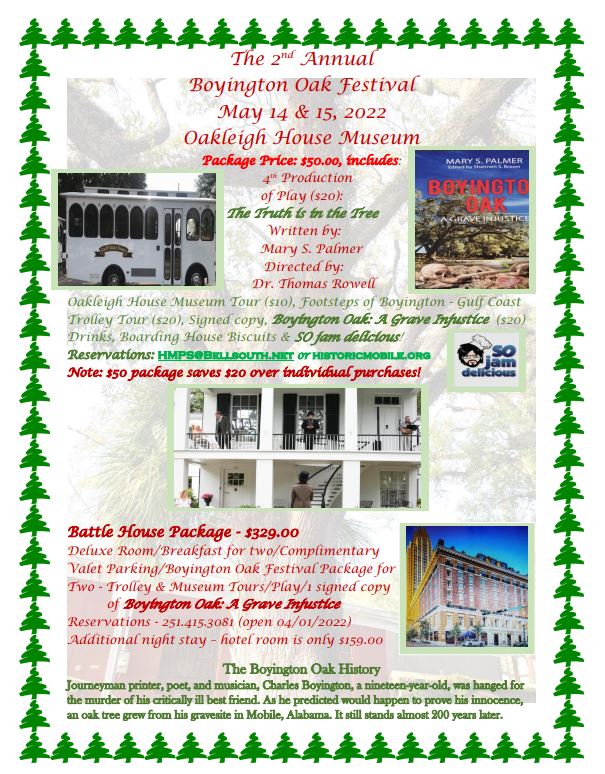But the path to their love was not smooth. Times were hard in the early part of the nineteenth century. Business had fallen off. In spring 1834, Boyington lost his job and was forced to borrow money from family and friends back in New Haven. He also managed to get money from his roommate, Nathaniel Frost, a fellow printer with tuberculosis whom he helped care for at a boarding house owned by Capt. and Mrs. William George. To make matters worse, he had gambling debts, and his debtors were threatening him.
Frost was discovered murdered in the Church Street Graveyard May 20, 1834, and as the last person seen with him, Boyington became the prime suspect. To compound suspicion, Frost had been stabbed repeatedly with a dirk, a printer’s knife. Boyington was placed in Mobile’s first jail, now the Condé-Charlotte House. At the time, the facility had no windows, fans, or heat. Boyington remained shackled to the wall through the hot summer and the cold winter. While awaiting trial, he wrote poetry to de Fleur, now his fiancé. His poetry was so good that local newspapers published his work, and he developed a following.
De Fleur loved Boyington, and she sneaked visits to the jail, risking punishment by her father. A local Presbyterian minister named William Hamilton also visited regularly and counseled Boyington. Assuming the prisoner was guilty, he urged him to confess and save his soul. But Boyington, an atheist, didn’t listen. He insisted he was innocent, saying sooner or later he would be vindicated.
The November trial brought more devastating news. Two jurors were unqualified: George Davis was a British citizen, and Chandler Waldo was convinced Boyington was guilty before the trial. The entire case was based on circumstantial evidence. Boyington was convicted and sentenced to hang.
On February 10, 1835, Boyington was marched from the jail to the woods he and de Fleur frequented during their courtship. This time, though, he was there to face his hanging. He continued to dispute his guilt, predicting that an oak tree would grow from his gravesite to prove his innocence. His lengthy final statement was stopped before the 4 p.m. deadline for the execution. When he spotted de Fleur in the crowd, he jumped from the gallows, trying to escape. Guards soon captured him, returned him to the gallows, and tightened the noose around his neck. His struggles delayed his death much longer than usual, and the crowd became horrified. People called out, “Murder,” at seeing his twitching and turning. But their cries went unheeded, and Boyington succumbed. His fate was sealed.
As he predicted, an oak tree sprouted from his gravesite and continued to grow throughout the years. Many acorns fall on the ground in that area; lots of them take root. Hurricanes and tornadoes fell plenty of those trees, but the Boyington Oak has survived for 185 years, so it, and Boyington’s story, has become a legend. Did it prove Boyington’s innocence, or was it merely superstition supported by a coincidence?
One discovery surprised a descendant of a judge associated with the Boyington case. Former Mobile District Attorney John M. Tyson Jr. learned that his great-grandfather, Judge John R. Tyson, heard a case in Hayneville, Alabama, in 1894 when the defense attorney, J. C. Richardson, said the Boyington trial showed how circumstantial evidence could result in a questionable verdict. He pointed to White’s deathbed confession and how it could have resulted in the Boyington case having a different outcome.
Another result of the case is the way juries are selected. Boyington’s case was denied an appeal by the Alabama Supreme Court, but it had an influence, as it led to a stronger adherence in the rules for jury selection. The legal system today takes more care in decisions, purging unqualified jurors before court proceedings begin.
Though Frost’s grave in Mobile’s Church Street Graveyard was unmarked, his friends placed a marker on Boyington’s grave to dub him a murderer. It remained until 1905. Another Boyington marker, put in place later, disappeared in 1971. However, with the 2019 publication of the book Boyington Oak: A Grave Injustice (Intellect Publishing Company), it seemed fitting to push for a new marker.
To promote that project, the Boyington Oak Society was formed and, with Historic Mobile Preservation Society’s help, the William Pomeroy Foundation provided a grant for a new marker. A Memorial Service Play was produced in March 2020 at GulfQuest Maritime Museum and by the Joe Jefferson Players at Historic Oakleigh Museum House in November 2020. Following that event, the new Historical Marker was unveiled at the Boyington Oak in Potter’s Field in Mobile’s Church Street Graveyard. The goal is to produce the play annually in Mobile.
But all is not done. With his dying breath, Boyington said he’d be vindicated sooner or later. The Boyington Oak Society is seeking a posthumous pardon to clear the Boyington name for collateral descendants such as Preston Boyington of Dothan, Alabama, and Shane Boyington of Loxley, Alabama. To reach this goal, it will be necessary to prove that Charles Boyington’s case should have resulted in a mistrial.

 RSS Feed
RSS Feed